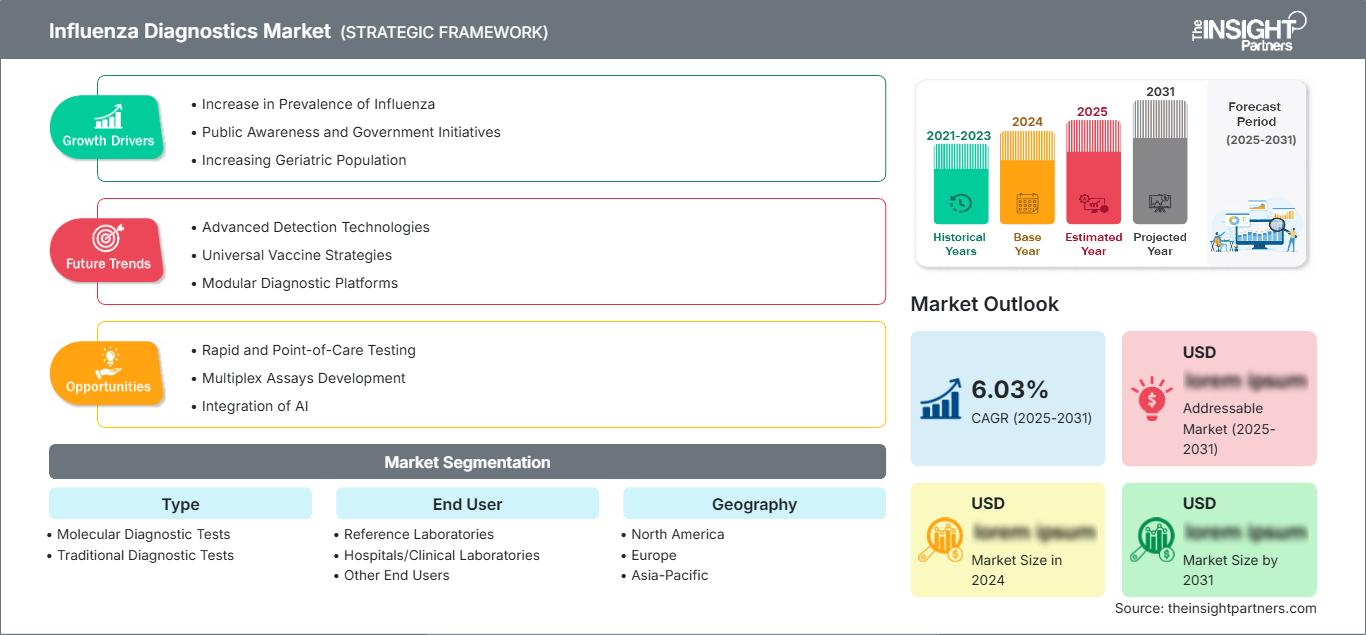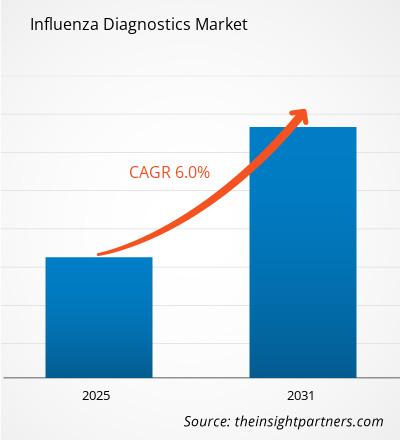Der Markt für Influenza-Diagnostik wird bis 2031 voraussichtlich ein Volumen von 2,3 Milliarden US-Dollar erreichen. Für den Zeitraum 2025–2031 wird ein jährliches Wachstum von 6,7 % erwartet.
Der Bericht ist nach Testtyp (molekulardiagnostische Tests, traditionelle diagnostische Tests) und Endnutzer (Referenzlabore, Krankenhäuser/klinische Labore, sonstige Endnutzer) segmentiert. Die globale Analyse wird zudem auf regionaler Ebene und für wichtige Länder aufgeschlüsselt. Die Werte für die oben genannten Analysen und Segmente werden in US-Dollar angegeben. Der Bericht „Influenza Diagnostics Market“ von The Insight Partners beschreibt die aktuelle Marktlage, das zukünftige Wachstum, die wichtigsten Wachstumstreiber, Herausforderungen und Chancen. Dies wird verschiedenen Geschäftspartnern Einblicke bieten, wie beispielsweise:
- Technologieanbieter/Hersteller: Um die sich entwickelnde Marktdynamik zu verstehen und potenzielle Wachstumschancen zu erkennen, damit sie fundierte strategische Entscheidungen treffen können.
- Investoren: Um eine umfassende Trendanalyse hinsichtlich der Marktwachstumsrate, der Finanzprognosen und der Chancen entlang der Wertschöpfungskette durchzuführen.
- Regulierungsbehörden: Um Richtlinien zu regulieren und Aktivitäten auf dem Markt zu überwachen, mit dem Ziel, Missbrauch zu minimieren, das Vertrauen der Investoren zu wahren und die Integrität und Stabilität des Marktes zu gewährleisten.
Marktsegmentierung für Grippediagnostik Typ
- Molekulardiagnostische Tests
- Traditionelle diagnostische Tests
Endnutzer
- Referenzlabore
- Krankenhäuser/Klinische Labore
- Sonstige Endnutzer
Sie erhalten kostenlos Anpassungen an jedem Bericht, einschließlich Teilen dieses Berichts oder einer Analyse auf Länderebene, eines Excel-Datenpakets sowie tolle Angebote und Rabatte für Start-ups und Universitäten.
Markt für Influenza-Diagnostik: Strategische Einblicke

-
Holen Sie sich die wichtigsten Markttrends aus diesem Bericht.Dieses KOSTENLOSE Beispiel umfasst Datenanalysen, die von Markttrends bis hin zu Schätzungen und Prognosen reichen.
Wachstumstreiber des Marktes für Grippediagnostik
- Zunehmende Grippeprävalenz: Die US-amerikanischen Zentren für Krankheitskontrolle und -prävention (CDC) gaben 2021 bekannt, dass 9 Millionen Patienten an Grippe erkrankt waren. Laut den Aktualisierungen der Weltgesundheitsorganisation (WHO) vom Februar 2021 testeten die WHO-GISRS-Labore im Zeitraum 2021–2022 über 490.516 Proben. Die steigenden Grippefälle weltweit treiben die Nachfrage nach Grippediagnostik zur Erkennung und Prävention der Krankheit an.
- Öffentliches Bewusstsein und staatliche Initiativen: Durch staatliche Gesundheitskampagnen wird das Bewusstsein für Grippe gestärkt, was die Bedeutung der Früherkennung erhöht und dazu führt, dass mehr Patienten eine Behandlung in Anspruch nehmen. Dies wiederum fördert die Nachfrage nach Grippediagnostik.
- Wachsende ältere Bevölkerung: Das starke Wachstum der älteren Bevölkerung treibt den Markt für Grippediagnostik an. Ältere Erwachsene sind anfälliger für Komplikationen durch Influenza, weshalb die Nachfrage nach diagnostischen Tests zur Behandlung ihrer Erkrankung steigt.
Zukünftige Trends im Markt für Influenza-Diagnostik
- Fortschrittliche Nachweistechnologien: Zukünftige Influenza-Diagnostika, die mit ausgefeilteren Nachweisstrategien, einschließlich Next-Generation-Sequenzierung und Genomtechnologien, entwickelt werden, ermöglichen eine höhere Sensitivität und Spezifität. Dies erlaubt die schnellere Identifizierung der beteiligten Influenzaviren und unterstützt somit die Entwicklung geeigneter Behandlungen und die Eindämmung von Ausbrüchen erheblich.
- Universelle Impfstrategien: Obwohl die Entwicklung panviraler Impfstoffe primär auf die Impfstoffentwicklung ausgerichtet sein wird, können neue Technologien auch Auswirkungen auf die Diagnostik haben. Diese Impfstoffe sind wirksamer bei der Bekämpfung konservierter Viruskomponenten und können daher zu einer besseren Identifizierung von Grippeviren beitragen, die für die Entwicklung von Diagnosetests genutzt werden könnten.
- Modulare Diagnoseplattformen: Zukünftige Diagnoseplattformen müssen so entwickelt werden, dass sie sich schnell an verschiedene Grippeviren oder andere Atemwegsviren anpassen können. Diese Anpassungsfähigkeit ermöglicht es, im Angesicht neuer Bedrohungen mit beispielloser Geschwindigkeit auf Aktualisierungen des Gesundheitssystems zu reagieren.
Marktchancen für Grippediagnostik
- Schnelltests und patientennahe Sofortdiagnostik: Die Entwicklung von Schnelltests für die patientennahe Sofortdiagnostik eröffnet lukrative Wachstumschancen im Markt für Grippediagnostik. Solche Tests werden Gesundheitsdienstleistern helfen, Influenza in Kliniken, Notaufnahmen und anderen Einrichtungen schneller zu diagnostizieren und so eine rasche Behandlung zu ermöglichen und die Ausbreitung des Virus zu minimieren.
- Entwicklung von Multiplex-Assays: Zukünftige Diagnostika könnten Multiplex-Assays umfassen, die gleichzeitig mehrere Atemwegserreger, darunter verschiedene Influenza-Subtypen, nachweisen können. Dies wird die Testverfahren optimieren und die allgemeine Effizienz der Diagnostik bei Atemwegserkrankungen verbessern und somit Chancen für Marktteilnehmer schaffen.
- Integration von KI: Die Rolle von KI und maschinellem Lernen bei der Influenza-Diagnostik wird von großer Bedeutung sein, um genauere und schnellere Ergebnisse zu liefern. Technologien in diesem Bereich können große Datensätze analysieren, indem sie vorherrschende Muster erkennen und Ausbrüche vorhersagen, wodurch die Maßnahmen gegen die Influenza-Bedrohung verstärkt werden.
Markt für Grippediagnostik
Die regionalen Trends und Einflussfaktoren auf den Markt für Grippediagnostik im gesamten Prognosezeitraum wurden von den Analysten von The Insight Partners ausführlich erläutert. Dieser Abschnitt behandelt außerdem die Marktsegmente und die geografische Verteilung des Marktes für das Management von Herzrhythmusstörungen in Nordamerika, Europa, Asien-Pazifik, dem Nahen Osten und Afrika sowie Süd- und Mittelamerika.
Umfang des Marktberichts zu Grippediagnostik
| Berichtsattribut | Einzelheiten |
|---|---|
| Marktgröße in 2024 | US$ XX Billion |
| Marktgröße nach 2031 | US$ 2.3 Billion |
| Globale CAGR (2025 - 2031) | 6.7% |
| Historische Daten | 2021-2023 |
| Prognosezeitraum | 2025-2031 |
| Abgedeckte Segmente |
By Typ
|
| Abgedeckte Regionen und Länder |
Nordamerika
|
| Marktführer und wichtige Unternehmensprofile |
|
Dichte der Akteure auf dem Markt für Grippediagnostik: Auswirkungen auf die Geschäftsdynamik
Der Markt für Grippediagnostik wächst rasant, angetrieben durch die steigende Nachfrage der Endverbraucher. Gründe hierfür sind unter anderem sich wandelnde Verbraucherpräferenzen, technologische Fortschritte und ein wachsendes Bewusstsein für die Vorteile des Produkts. Mit steigender Nachfrage erweitern Unternehmen ihr Angebot, entwickeln innovative Lösungen, um den Bedürfnissen der Verbraucher gerecht zu werden, und nutzen neue Trends, was das Marktwachstum zusätzlich beflügelt.

- Holen Sie sich die Markt für Influenza-Diagnostik Übersicht der wichtigsten Akteure
Wichtigste Verkaufsargumente
- Umfassende Abdeckung: Der Bericht bietet eine umfassende Analyse der Produkte, Dienstleistungen, Typen und Endnutzer des Marktes für Grippediagnostik und vermittelt so ein ganzheitliches Bild.
- Expertenanalyse: Der Bericht basiert auf dem fundierten Wissen von Branchenexperten und Analysten.
- Aktuelle Informationen: Der Bericht gewährleistet Geschäftsrelevanz durch die Berücksichtigung aktueller Informationen und Datentrends.
- Anpassungsmöglichkeiten: Dieser Bericht kann an spezifische Kundenanforderungen angepasst werden und sich optimal in die Geschäftsstrategien integrieren.
Der Forschungsbericht zum Markt für Grippediagnostik kann daher maßgeblich dazu beitragen, das Branchenszenario und die Wachstumsaussichten zu entschlüsseln und zu verstehen. Auch wenn einige berechtigte Bedenken bestehen, überwiegen die Vorteile dieses Berichts insgesamt die Nachteile.
- Historische Analyse (2 Jahre), Basisjahr, Prognose (7 Jahre) mit CAGR
- PEST- und SWOT-Analyse
- Marktgröße Wert/Volumen – Global, Regional, Land
- Branchen- und Wettbewerbslandschaft
- Excel-Datensatz
Aktuelle Berichte
Erfahrungsberichte
Grund zum Kauf
- Fundierte Entscheidungsfindung
- Marktdynamik verstehen
- Wettbewerbsanalyse
- Kundeneinblicke
- Marktprognosen
- Risikominimierung
- Strategische Planung
- Investitionsbegründung
- Identifizierung neuer Märkte
- Verbesserung von Marketingstrategien
- Steigerung der Betriebseffizienz
- Anpassung an regulatorische Trends






















 Kostenlose Probe anfordern für - Markt für Influenza-Diagnostik
Kostenlose Probe anfordern für - Markt für Influenza-Diagnostik